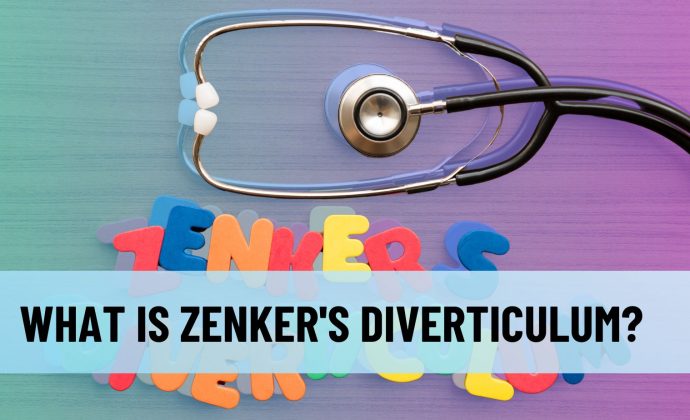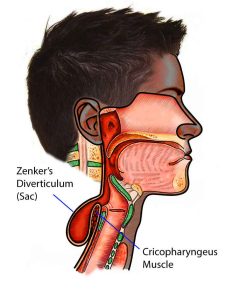
WHAT IS ZENKER’S DIVERTICULUM?
Diverticulum is a medical term that refers to an abnormal structure such as a sac. Diverticula can form almost anywhere in the digestive tract. Zenker’s diverticulum is a sac that develops in the hypopharynx, usually between the cricopharyngeus (CP) and the inferior pharyngeal constrictor muscle. Zenker’s diverticulum only involves the mucosa and submucosa layers and doesn’t involve the muscular layer. Zenker’s diverticulum can also occur in other parts of the esophagus, such as between the oblique and transverse fibers of the CP muscle, known as the Killian-Jamieson area, and between the CP muscle and the esophageal muscles, known as Laimer triangle.
This condition is quite rare. The incidence rate ranges from 0.01%-0.11% of the population. Zenker’s diverticulum can occur because the esophageal tissue tears due to too much pressure.
 Picture 1. Zenker’s Diverticulum (Nesheiwat, et al 2023)
Picture 1. Zenker’s Diverticulum (Nesheiwat, et al 2023)
Zenker diverticulum formation is associated with upper esophageal sphincter dysfunction. When the upper esophageal sphincter does not open completely, it puts pressure on the pharyngeal wall area. This excess pressure gradually pushes the tissue outward, causing it to form a diverticulum. Gastroesophageal reflux disease (GERD) and age-related changes in tissue composition and muscle tone are also thought to play a role in this process.
Symptoms
The most common symptom of Zenker’s diverticulum is difficulty swallowing or dysphagia. 90% of people who suffer from Zenker’s diverticulum will have difficulty swallowing solid and liquid food. Some other common symptoms are weight loss, halitosis (bad breath) due to food getting stuck in the diverticulum, persistent coughing especially at night, regurgitation of undigested food, hoarseness or voice changes, an aspiration which can cause pneumonia, voice gurgling from the throat (gurgling noise), feeling like something is stuck in the throat. Zenker diverticulum can be associated with hernias, esophageal cancer (rare), esophageal spasm, and GERD.
Diagnosis and Test
Zenker diverticulum can be identified by doing an esophagram or barium swallow test. Barium swallow with videofluoroscopy provides information regarding the size, location, and character of the mucosal lining, and diagnoses the condition.
Another test to diagnose Zenker’s diverticulum is an upper endoscopy which gives an idea of the sac and how large it is.
The final possibility for diagnosing Zenker’s diverticulum is using esophageal manometry. This test studies the pressure in the esophagus.
The staging of Zenker’s diverticulum is critical to the overall evaluation. There are three staging systems: Lahey, Morton, and Van Overbeek staging system. Only one of the 3 may be used. The staging is typically reliant on the size of the pouch the bigger the size, the higher the staging.
Treatment
Zenker diverticulum can be treated with an open procedure or through an endoscopic approach. During surgery, it is very important to divide the cricopharyngeus muscle to eliminate the high-pressure zone and remove the diverticulum sac. A myotomy of 1 cm is sufficient in most cases.
Treatment for Zenker’s diverticulum depends on the size and severity of the sac. If the diverticulum is less than ¼ inch or if the patient is not experiencing any bothersome symptoms, the patient likely does not need a surgical procedure. Patients are advised to consult a doctor to find out the right treatment.
Reviewed by Rabbinu Rangga Pribadi, MD, Consultant of Gastroenterohepatology
Source:
Nesheiwat Z, Antunes C. Zenker Diverticulum. [Updated 2023 Aug 8]. In: StatPearls [Internet]. Treasure Island (FL): StatPearls Publishing; 2023 Jan-. Available from: https://www.ncbi.nlm.nih.gov/books/NBK499996/
WebMD. 2023. What is Zenker’s Diverticulum?. From: Zenker’s Diverticulum: Symptoms and Treatment (webmd.com)
Image source:
Getty Images





 Users Today : 292
Users Today : 292 Total views : 2186821
Total views : 2186821 Who's Online : 8
Who's Online : 8